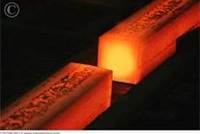Steel Shines Anew: NAIAS 2013 Reaffirms Steel's Dominant Role In Automotive Industry
 |
Steel helps automakers create affordable, sustainable vehicles for society's evolving needs
DETROIT--Jan. 22, 2013: Steel continues to dominate as the lightweight automotive material that best addresses society's need for reduced greenhouse gas emissions, improved safety, increased performance and affordability at this year's North American International Auto Show (NAIAS) in Detroit. As winners were announced and vehicles were unveiled, advanced grades of steel stood strong. According to the Steel Market Development Institute (SMDI), a business unit of the American Iron and Steel Institute (AISI), steel is undergoing significant reinvention due to its unique ability to be modified and tuned to meet the demands of automakers and the industry.
Some noteworthy steel successes from NAIAS 2013 include:
- 2013 North American Car and Truck / Utility of the Year award winners, the Cadillac ATS and Dodge Ram 1500, both feature an extensive amount of advanced high-strength steel (AHSS);
- 2013 Kia Optima, the International Car of the Year, uses AHSS to enhance structural integrity, stiffness and ride quality;
- 2014 Jeep Grand Cherokee incorporates AHSS to help it achieve best-in-class fuel economy, while keeping drivers and passengers safe;
- According to General Motors, Chevrolet's "strongest ever" 2014 Silverado 1500 full-size pickup features AHSS main rails and cross members with hydroformed elements for reduced mass and improved strength. Nearly two-thirds of the new truck cab structure is made from AHSS;
- New Cadillac ELR incorporates AHSS to add strength and conserve weight;
- Mercedes-Benz E-Class unveiled at reduced weight and with improved fuel economy due to advanced steel technologies;
- Hyundai HCD-14 Genesis concept design highlights the use of high-tensile steel in its ultra-rigid chassis; and
- All-new BMW 320i features a lightweight design using high and ultra-high tensile steels.
"Steel continues to dominate as the material of choice for vehicles because it's one of the strongest materials in the world today and offers the best combination of safety, fuel efficiency and affordability," Ron Krupitzer, vice president, automotive applications for SMDI, said. "When you consider the total benefits of steel -- weight that's on par with competitive materials, lowest cost, repairability and the existing manufacturing infrastructure -- it's the only available material that offers automakers the complete package they seek to succeed in the changing automotive industry."
Over the last six years, steel usage remained constant at 58 to 62 percent of total vehicle content by weight despite inter-material competition (Mega Associates). With recent programs, such as SMDI's (WorldAutoSteel's) FutureSteelVehicle project that introduced more than 20 new grades of AHSS, and upcoming programs aimed at lightweighting engine and chassis components, steel continues to evolve and further increase its competitiveness to keep its place at a leading material choice for vehicles of the future.


